儿童屈光不正光学生物测量的探讨
儿童屈光不正诊断和矫正方法
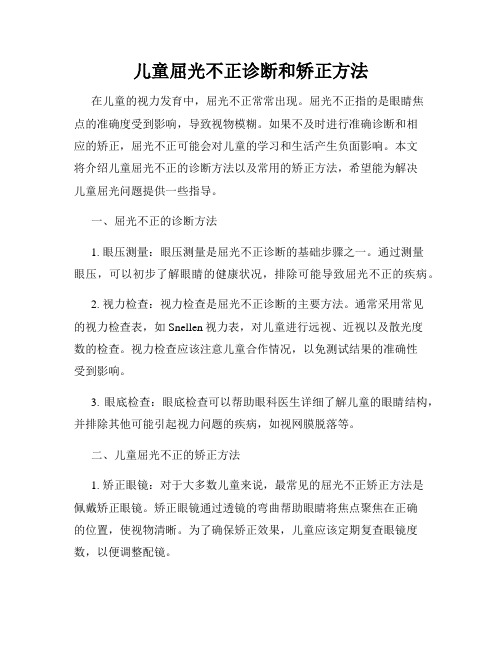
儿童屈光不正诊断和矫正方法在儿童的视力发育中,屈光不正常常出现。
屈光不正指的是眼睛焦点的准确度受到影响,导致视物模糊。
如果不及时进行准确诊断和相应的矫正,屈光不正可能会对儿童的学习和生活产生负面影响。
本文将介绍儿童屈光不正的诊断方法以及常用的矫正方法,希望能为解决儿童屈光问题提供一些指导。
一、屈光不正的诊断方法1. 眼压测量:眼压测量是屈光不正诊断的基础步骤之一。
通过测量眼压,可以初步了解眼睛的健康状况,排除可能导致屈光不正的疾病。
2. 视力检查:视力检查是屈光不正诊断的主要方法。
通常采用常见的视力检查表,如Snellen视力表,对儿童进行远视、近视以及散光度数的检查。
视力检查应该注意儿童合作情况,以免测试结果的准确性受到影响。
3. 眼底检查:眼底检查可以帮助眼科医生详细了解儿童的眼睛结构,并排除其他可能引起视力问题的疾病,如视网膜脱落等。
二、儿童屈光不正的矫正方法1. 矫正眼镜:对于大多数儿童来说,最常见的屈光不正矫正方法是佩戴矫正眼镜。
矫正眼镜通过透镜的弯曲帮助眼睛将焦点聚焦在正确的位置,使视物清晰。
为了确保矫正效果,儿童应该定期复查眼镜度数,以便调整配镜。
2. 隐形眼镜:对于一些年龄较大的儿童和青少年,他们可能更喜欢使用隐形眼镜进行矫正。
隐形眼镜可以提供更自然的视觉体验,并且不会影响外观。
然而,隐形眼镜需要儿童具备良好的眼部卫生意识和正确使用方法,家长应给予指导和监督。
3. 视光矫正训练:对于一些轻度的屈光不正,视光矫正训练可能是一种辅助的矫正方法。
这种训练通过一系列眼部运动、注意力和协调练习来增强眼肌的功能,从而改善视力。
4. 屈光手术:对于一些情况严重的儿童,如高度近视或散光,医生可能会考虑屈光手术。
然而,屈光手术对于儿童而言风险较大,应该在医生的指导下进行充分的评估和决策。
三、预防和提前发现屈光不正1. 定期眼科检查:儿童在3岁前应该首次进行眼科检查,之后每年至少进行一次。
定期检查可以及早发现潜在的屈光不正问题,并采取相应的矫正措施。
四到五岁儿童正常生理屈光度为
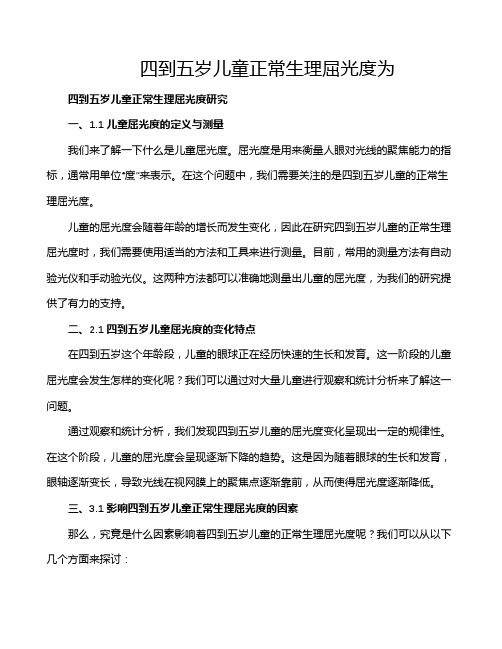
四到五岁儿童正常生理屈光度为四到五岁儿童正常生理屈光度研究一、1.1 儿童屈光度的定义与测量我们来了解一下什么是儿童屈光度。
屈光度是用来衡量人眼对光线的聚焦能力的指标,通常用单位“度”来表示。
在这个问题中,我们需要关注的是四到五岁儿童的正常生理屈光度。
儿童的屈光度会随着年龄的增长而发生变化,因此在研究四到五岁儿童的正常生理屈光度时,我们需要使用适当的方法和工具来进行测量。
目前,常用的测量方法有自动验光仪和手动验光仪。
这两种方法都可以准确地测量出儿童的屈光度,为我们的研究提供了有力的支持。
二、2.1 四到五岁儿童屈光度的变化特点在四到五岁这个年龄段,儿童的眼球正在经历快速的生长和发育。
这一阶段的儿童屈光度会发生怎样的变化呢?我们可以通过对大量儿童进行观察和统计分析来了解这一问题。
通过观察和统计分析,我们发现四到五岁儿童的屈光度变化呈现出一定的规律性。
在这个阶段,儿童的屈光度会呈现逐渐下降的趋势。
这是因为随着眼球的生长和发育,眼轴逐渐变长,导致光线在视网膜上的聚焦点逐渐靠前,从而使得屈光度逐渐降低。
三、3.1 影响四到五岁儿童正常生理屈光度的因素那么,究竟是什么因素影响着四到五岁儿童的正常生理屈光度呢?我们可以从以下几个方面来探讨:1.遗传因素:遗传因素是影响儿童屈光度的重要原因之一。
如果孩子的父母或祖辈中有近视或者远视等屈光不正的病史,那么孩子患上近视或者远视的风险就会相应增加。
2.环境因素:环境因素也是影响儿童屈光度的重要原因。
长时间近距离看书、玩电子产品等不良用眼习惯会导致眼睛疲劳,进而影响眼球的生长和发育,从而导致屈光度异常。
3.营养因素:合理的营养摄入对于儿童的眼睛健康至关重要。
缺乏维生素A、钙等营养素会影响儿童眼睛的正常发育,进而影响屈光度。
4.其他因素:还有一些其他因素也可能影响到儿童的屈光度,如早产、低体重等。
这些因素可能会导致儿童眼睛发育不完全,从而影响屈光度。
四、4.1 预防四到五岁儿童屈光度异常的方法既然我们已经了解了影响四到五岁儿童正常生理屈光度的因素,那么如何预防屈光度异常呢?我们可以从以下几个方面来着手:1.加强宣传教育:家长和老师要加强对孩子用眼卫生的教育,让孩子养成良好的用眼习惯,避免长时间近距离看书、玩电子产品等不良用眼行为。
对学龄前儿童屈光及视力发育情况的调查分析

要点二
屈光及视力发育异常的康复训 练方法
主要包括视觉训练、眼肌训练、心理辅导等。
05
研究结论与展望
研究结论
01
02
03
屈光状态
学龄前儿童的屈光状态具 有较高的变化性,需要定 期进行视力检查,以早期 发现和预防近视。
视力发育
学龄前儿童的视力发育与 年龄密切相关,应注重保 护儿童视力,避免过度使 用电子产品。
视力发育的规律
学龄前儿童的视力发育呈现出一定的规 律性,即出生后视力逐渐提高,到3岁左 右视力达到0.6以上,5-6岁左右达到0.8 左右,7岁左右达到0.9左右,接近成人 水平。
VS
视力发育的特点
学龄前儿童的视力发育具有以下几个特点 :1)视力不稳定,容易受到外界环境的 影响;2)对色彩鲜艳、对比度高的物体 更敏感;3)通过锻炼和训练可以促进视 力的发育。
近年来,随着电子产品普及和近距离用眼时间增加,学龄前儿童的屈光及视力问 题日益突出,因此开展相关调查研究具有重要的现实意义和社会价值。
研究目的和方法
研究目的
了解学龄前儿童的屈光及视力发育情况,分析其影响因素,为制定相应的预防 和治疗措施提供科学依据。
研究方法
采用横断面研究设计,选取某城市幼儿园的学龄前儿童为研究对象,通过问卷 调查、体格检查和眼科检查收集相关信息,运用统计学方法进行分析。
学龄前儿童应该尽量避免长时间盯着电子 屏幕,多进行户外活动,保护好自己的视 力。
未来需要继续对学龄前儿童的屈光和视力 发育进行深入研究,探索更多影响儿童视 力发育的因素,为儿童视力保护提供更加 科学和有效的建议。
感谢您的观看
学龄儿童近视眼屈光状态与生物学参数的相关性分析
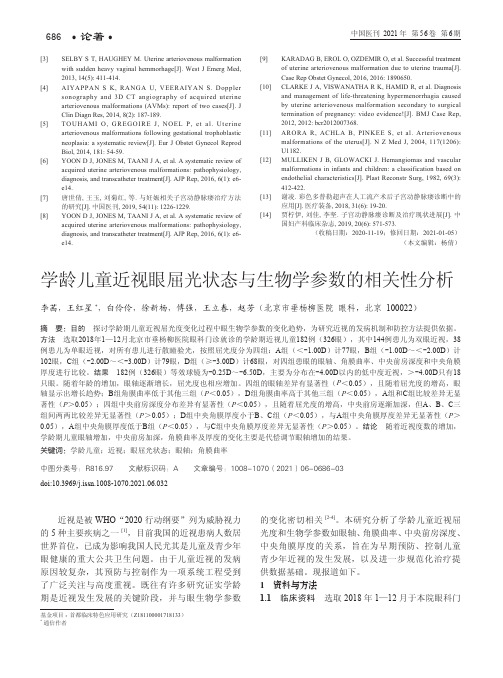
686·论著·中国医刊 2021 年 第56卷 第6期[3]SELBY S T, HAUGHEY M. Uterine arteriovenous malformation with sudden heavy vaginal hemmorhage[J]. West J Emerg Med, 2013, 14(5): 411-414.[4]AIYAPPAN S K, RANGA U, VEERAIYAN S. Doppler sonography and 3D CT angiography of acquired uterine arteriovenous malformations (AVMs): report of two cases[J]. J Clin Diagn Res, 2014, 8(2): 187-189.[5]TOUHAMI O, GREGOIRE J, NOEL P, et al. Uterine arteriovenous malformations following gestational trophoblastic neoplasia: a systematic review[J]. Eur J Obstet Gynecol Reprod Biol, 2014, 181: 54-59.[6]YOON D J, JONES M, TAANI J A, et al. A systematic review of acquired uterine arteriovenous malformations: pathophysiology, diagnosis, and transcatheter treatment[J]. AJP Rep, 2016, 6(1): e6-e14.[7] 唐世倩, 王玉, 刘菊红, 等. 与妊娠相关子宫动静脉瘘治疗方法的研究[J]. 中国医刊, 2019, 54(11): 1226-1229.[8]YOON D J, JONES M, TAANI J A, et al. A systematic review of acquired uterine arteriovenous malformations: pathophysiology, diagnosis, and transcatheter treatment[J]. AJP Rep, 2016, 6(1): e6-e14.[9]KARADAG B, EROL O, OZDEMIR O, et al. Successful treatmentof uterine arteriovenous malformation due to uterine trauma[J]. Case Rep Obstet Gynecol, 2016, 2016: 1890650.[10]CLARKE J A, VISWANATHA R K, HAMID R, et al. Diagnosis and management of life-threatening hypermenorrhagia caused by uterine arteriovenous malformation secondary to surgical termination of pregnancy: video evidence![J]. BMJ Case Rep, 2012, 2012: bcr2012007368.[11]ARORA R, ACHLA B, PINKEE S, et al. Arteriovenous malformations of the uterus[J]. N Z Med J, 2004, 117(1206): U1182.[12]MULLIKEN J B, GLOWACKI J. Hemangiomas and vascular malformations in infants and children: a classification based on endothelial characteristics[J]. Plast Reconstr Surg, 1982, 69(3): 412-422.[13] 谢凌. 彩色多普勒超声在人工流产术后子宫动静脉瘘诊断中的应用[J]. 医疗装备, 2018, 31(6): 19-20.[14]贾柠伊, 刘佳, 李坚. 子宫动静脉瘘诊断及治疗现状进展[J]. 中国妇产科临床杂志, 2019, 20(6): 571-573.(收稿日期:2020-11-19;修回日期:2021-01-05)(本文编辑:杨倩)学龄儿童近视眼屈光状态与生物学参数的相关性分析李茜,王红星*,白伶伶,徐新杨,傅强,王立春,赵芳(北京市垂杨柳医院 眼科,北京 100022)摘 要:目的 探讨学龄期儿童近视屈光度变化过程中眼生物学参数的变化趋势,为研究近视的发病机制和防控方法提供依据。
屈光不正性弱视和正常儿童立体视觉的临床观察
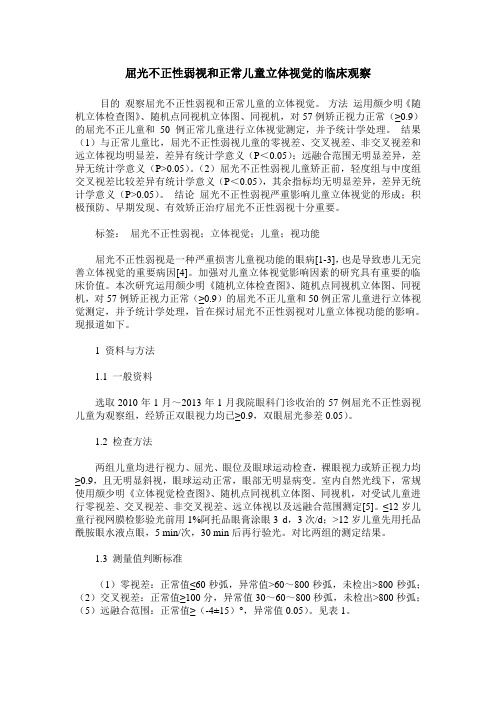
屈光不正性弱视和正常儿童立体视觉的临床观察目的观察屈光不正性弱视和正常儿童的立体视觉。
方法运用颜少明《随机立体检查图》、随机点同视机立体图、同视机,对57例矫正视力正常(≥0.9)的屈光不正儿童和50例正常儿童进行立体视觉测定,并予统计学处理。
结果(1)与正常儿童比,屈光不正性弱视儿童的零视差、交叉视差、非交叉视差和远立体视均明显差,差异有统计学意义(P<0.05);远融合范围无明显差异,差异无统计学意义(P>0.05)。
(2)屈光不正性弱视儿童矫正前,轻度组与中度组交叉视差比较差异有统计学意义(P<0.05),其余指标均无明显差异,差异无统计学意义(P>0.05)。
结论屈光不正性弱视严重影响儿童立体视觉的形成;积极预防、早期发现、有效矫正治疗屈光不正性弱视十分重要。
标签:屈光不正性弱视;立体视觉;儿童;视功能屈光不正性弱视是一种严重损害儿童视功能的眼病[1-3],也是导致患儿无完善立体视觉的重要病因[4]。
加强对儿童立体视觉影响因素的研究具有重要的临床价值。
本次研究运用颜少明《随机立体检查图》、随机点同视机立体图、同视机,对57例矫正视力正常(≥0.9)的屈光不正儿童和50例正常儿童进行立体视觉测定,并予统计学处理,旨在探讨屈光不正性弱视对儿童立体视功能的影响。
现报道如下。
1 资料与方法1.1 一般资料选取2010年1月~2013年1月我院眼科门诊收治的57例屈光不正性弱视儿童为观察组,经矫正双眼视力均已≥0.9,双眼屈光参差0.05)。
1.2 检查方法两组儿童均进行视力、屈光、眼位及眼球运动检查,裸眼视力或矫正视力均≥0.9,且无明显斜视,眼球运动正常,眼部无明显病变。
室内自然光线下,常规使用颜少明《立体视觉检查图》、随机点同视机立体图、同视机,对受试儿童进行零视差、交叉视差、非交叉视差、远立体视以及远融合范围测定[5]。
≤12岁儿童行视网膜检影验光前用1%阿托品眼膏涂眼3 d,3次/d;>12岁儿童先用托品酰胺眼水液点眼,5 min/次,30 min后再行验光。
5-16岁青少年儿童眼部屈光状态与生物学参数的相关性分析

分类号:R77 单位代码:10343学号:*********硕士学位论文论文题目:5-16岁青少年儿童眼部屈光状态与生物学参数的相关性分析研究生姓名:张煜学科专业:眼科学类型:专业型指导教师:郑海华教授二O一八年五月论文题目: 5-16岁青少年儿童眼部屈光状态与生物学参数的相关性分析答辩委员会主席:杜持新教授浙江大学医学院附属第一医院答辩委员会成员:郑穗联副教授温州医科大学附属第二医院蔡剑秋副教授温州医科大学附属第二医院论文答辩日期:2018年5月24日目录缩略词表 (1)中文摘要 (2)英文摘要 (4)前言 (6)资料与方法 (7)结果 (9)讨论与分析 (22)结论 (24)参考文献 (25)致谢 (29)综述 (30)参考文献 (35)学位论文独创性声明 (41)缩略词表英文缩写英文中文ACD anterior chamber depth前房深度K Corneal curvature角膜曲率CR corneal curvature radius角膜曲率半径WTW White to white角膜白到白AM Ametropia屈光不正MY Myopia近视眼D Diopter屈光度SE spherical equivalent等效球镜度mm Millimeter毫米ρSpearman's rankspearman相关系数correlation coefficient5-16岁青少年儿童眼部屈光状态与生物学参数的相关性分析摘要目的:研究5-16岁青少年儿童在不同眼屈光度数组以及不同年龄段之间的眼生物学参数的差异,主要包括眼轴(AL)、角膜曲率(K)、前房深度(ACD)以及角膜直径(WTW),探究在青少年屈光状态的变化过程中眼生物学参数的变化趋势。
方法:随机选择2016年7月-2017年5月温州地区中小学近视筛查回访的青少年1340例2673只眼,年龄分布在5-16岁,平均年龄(10.207±2.63)岁,所有入选儿童排除眼部的器质性病变(包括白内障、斜视、眼底病变)以及全身疾病,进行检影验光、裂隙灯检查、眼光学相干生物测量仪(IOLmaster)检查、优势眼检查。
儿童屈光特点验光配镜讨论
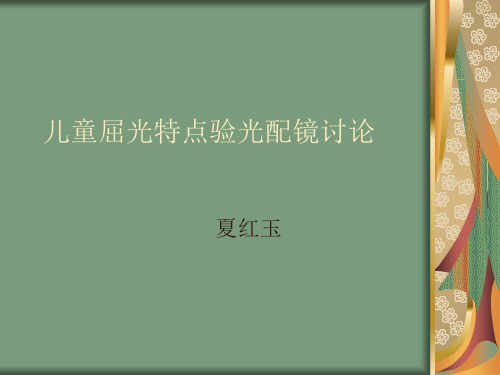
儿童眼屈光参差 双眼屈光程度不等(>2D以上) 屈光参差矫正原则尽量充分矫正,常戴, 治疗弱视。
三、儿童验光检查
二、儿童屈光不正的矫正
儿童远视眼的特点: 1、早年远视的生理性 2、通过调节,远近视力可保持正常 3、调节过强可致假性近视 4、调节与辐辏保持生理协调与平衡可 导致多种眼肌与屈光异常,如过度调 节、辐辏过强内斜等
儿童远视眼的配镜原则
单纯远视眼,指视力可矫正到正常, 可按“验光度数轻度低矫,以最佳视 力而又不引起视疲劳”予以配镜。生 理性远视可不予配镜。(度数减得越 多使用调节越多,越容易引起视疲劳)
远视合并外斜 在最佳矫正视力的前提下,给予尽可 能的低矫。
无晶体眼的矫正 包括:配戴眼镜、角膜接触镜以及人 工晶体的植入。 无晶体眼屈光调节功能完全消失,需 要配戴不同距离的眼镜。
儿童近视眼的配镜原则 儿童期出现的近视眼总是发展的,且 多为病理性,是不可逆的。 近视的概念:远视力低常,近视力正 常,近视眼(屈光概念)静态屈光为 近视状态。如动态屈光呈现的假性近 视眼,其实质常常是远视眼,并非为 近视的早期阶段。近视眼病(疾病概 念)为病理性近视。
儿童屈光特点验光配镜讨论
夏红玉
一、儿童视光学 儿童视光学是利用现代视光技术研究 儿童眼屈光视功能特点及二者间的关 系,并采取科学、有效、合理的方法 与手段,促进和保证儿童眼的正常发 育,矫治屈光不正,恢复、保护、增 进视觉功能。临床视光学是属于小儿 眼科及儿童眼保健的范畴。
儿童眼病的防治原则
早防早治,争取功能矫正,维持 或恢复双眼视功能。
远视合并弱视 以提高视力为主,同时尽量足矫,可 在验光度数上减0.5~1D,(弱视眼为 懒眼),待视力提高再多减,调用调 节。(一般减1/3验光度数)
儿童视光学相关问题讨论(下)
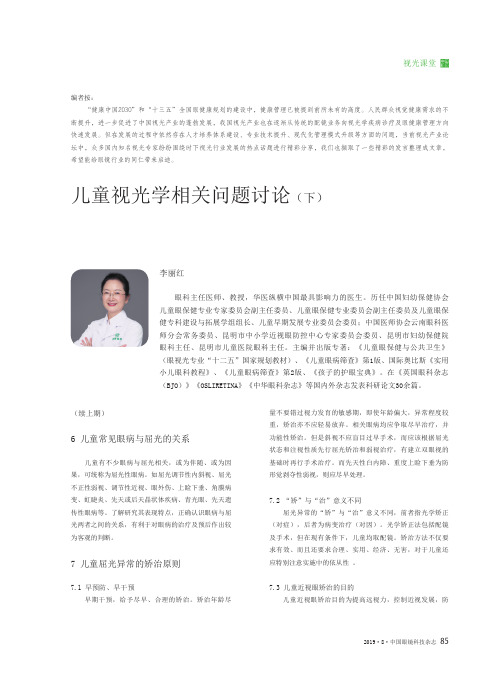
编者按:“健康中国2030”和“十三五”全国眼健康规划的建设中,健康管理已被提到前所未有的高度。
人民群众视觉健康需求的不断提升,进一步促进了中国视光产业的蓬勃发展,我国视光产业也在逐渐从传统的配镜业务向视光学疾病诊疗及眼健康管理方向快速发展。
但在发展的过程中依然存在人才培养体系建设、专业技术提升、现代化管理模式升级等方面的问题,当前视光产业论坛中,众多国内知名视光专家纷纷围绕时下视光行业发展的热点话题进行精彩分享,我们也撷取了一些精彩的发言整理成文章,希望能给眼镜行业的同仁带来启迪。
(续上期)6 儿童常见眼病与屈光的关系儿童有不少眼病与屈光相关,或为伴随、或为因果,可统称为屈光性眼病。
如屈光调节性内斜视、屈光不正性弱视、调节性近视、眼外伤、上睑下垂、角膜病变、虹睫炎、先天或后天晶状体疾病、青光眼、先天遗传性眼病等。
了解研究其表现特点,正确认识眼病与屈光两者之间的关系,有利于对眼病的治疗及预后作出较为客观的判断。
7 儿童屈光异常的矫治原则7.1 早预防、早干预早期干预,给予尽早、合理的矫治。
矫治年龄尽儿童视光学相关问题讨论(下)李丽红眼科主任医师、教授,华医纵横中国最具影响力的医生。
历任中国妇幼保健协会儿童眼保健专业专家委员会副主任委员、儿童眼保健专业委员会副主任委员及儿童眼保健专科建设与拓展学组组长、儿童早期发展专业委员会委员;中国医师协会云南眼科医师分会常务委员、昆明市中小学近视眼防控中心专家委员会委员、昆明市妇幼保健院眼科主任、昆明市儿童医院眼科主任。
主编并出版专著:《儿童眼保健与公共卫生》(眼视光专业“十二五”国家规划教材)、《儿童眼病筛查》第1版、国际奥比斯《实用小儿眼科教程》、《儿童眼病筛查》第2版、《孩子的护眼宝典》。
在《英国眼科杂志(BJO)》《OSLIRETINA》《中华眼科杂志》等国内外杂志发表科研论文30余篇。
量不要错过视力发育的敏感期,即使年龄偏大,异常程度较重,矫治亦不应轻易放弃。
学龄前儿童视力不良眼的屈光异常调查分析
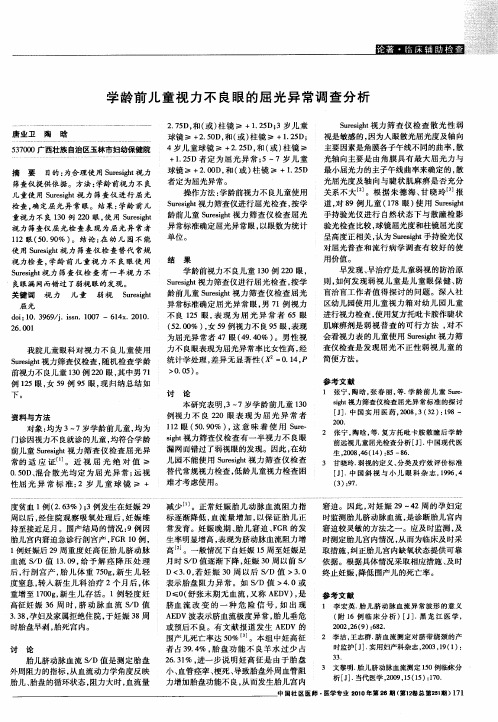
难 才考 虑使 用。
减少 … 。正常妊 娠胎儿 动脉 血流 阻力指 标逐渐 降低 , 流量增 加 , 血 以保证 胎 儿正 常发育 。妊娠 晚期 、 儿窘迫 、 G 胎 F R的发 生率 明显增高 , 表现为脐动脉血流阻力增 高 J 。一般情况下 自妊娠 1 5周至妊娠足 月时 S D值 逐渐下降 , / 妊娠 3 O周 以前 s / D<30 若妊 娠 3 ., 0周 以后 S D值 >3 0 / . 表示胎盘 阻力 异常 。如 S D值 >4 0或 / . D≤0 舒张末期 无血 流 , ( 又称 A D , E V) 是 脐血 流 改 变 的一 种 危 险 信 号 , 出 现 如 AD E V波表示脐血 流极度 异常 , 胎儿垂 危 或预后不 良。有 文献 报道发 生 A D E V的 围产儿死亡率达 5 % 。本 组 中妊 高征 0 者 占 3.% , 94 胎盘 功 能不 良羊水 过 少 占 2. l , 63 % 进一步 说 明妊 高征是 由于胎 盘 小 、 管痉挛 、 血 梗死 、 导致胎盘外周 血管阻 力增加胎盘功能不 良, 而发 生胎 儿宫内 从
2 张宁 , 陶晗 , . 等 复方托 吡卡胺 散瞳后 学龄 前远视儿童屈光检查分析 [ ] 中国现代医 J.
生 ,0 8,6 1 :5—8 . 20 4 (4)8 6 3 甘 晓玲. 弱视的定义 、 类及 疗效评 价标准 分
[] J .中 国斜 视 与 小 儿 眼 科 杂 志 ,9 6, 19 4
良 眼漏 网而 错 过 了弱 视 眼 的 发 现 。
关键词
屈 光
学 龄前视力不 良儿童 10例 20眼 , 3 2 S rs h 视力筛查仪进行屈光 检查 , uei t g 按学
视 力 儿 童 弱 视
眼屈光要素生物学测量23.68
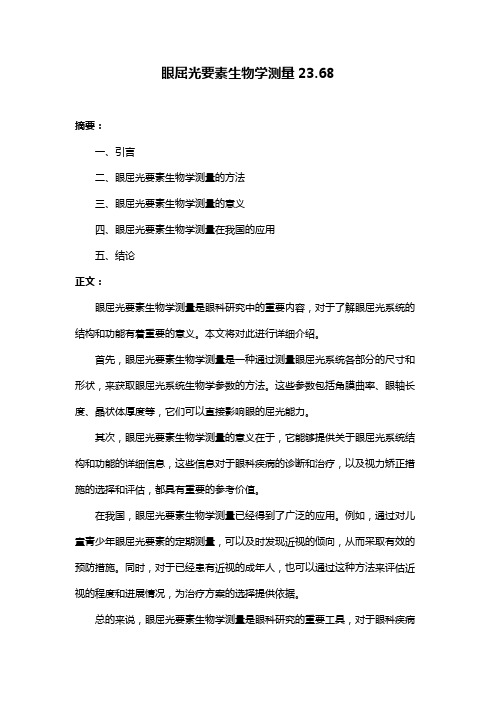
眼屈光要素生物学测量23.68
摘要:
一、引言
二、眼屈光要素生物学测量的方法
三、眼屈光要素生物学测量的意义
四、眼屈光要素生物学测量在我国的应用
五、结论
正文:
眼屈光要素生物学测量是眼科研究中的重要内容,对于了解眼屈光系统的结构和功能有着重要的意义。
本文将对此进行详细介绍。
首先,眼屈光要素生物学测量是一种通过测量眼屈光系统各部分的尺寸和形状,来获取眼屈光系统生物学参数的方法。
这些参数包括角膜曲率、眼轴长度、晶状体厚度等,它们可以直接影响眼的屈光能力。
其次,眼屈光要素生物学测量的意义在于,它能够提供关于眼屈光系统结构和功能的详细信息,这些信息对于眼科疾病的诊断和治疗,以及视力矫正措施的选择和评估,都具有重要的参考价值。
在我国,眼屈光要素生物学测量已经得到了广泛的应用。
例如,通过对儿童青少年眼屈光要素的定期测量,可以及时发现近视的倾向,从而采取有效的预防措施。
同时,对于已经患有近视的成年人,也可以通过这种方法来评估近视的程度和进展情况,为治疗方案的选择提供依据。
总的来说,眼屈光要素生物学测量是眼科研究的重要工具,对于眼科疾病
的诊断和治疗,以及视力保健都有着重要的意义。
眼科门诊儿童屈光不正及斜视弱视状况的调查研究
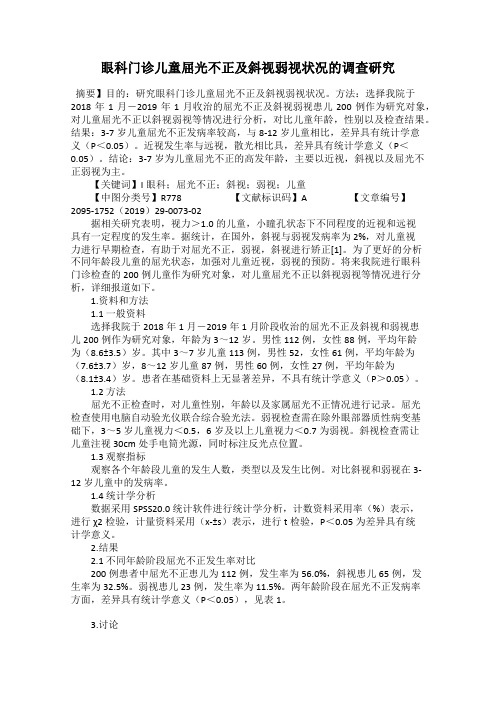
眼科门诊儿童屈光不正及斜视弱视状况的调查研究摘要】目的:研究眼科门诊儿童屈光不正及斜视弱视状况。
方法:选择我院于2018年1月-2019年1月收治的屈光不正及斜视弱视患儿200例作为研究对象,对儿童屈光不正以斜视弱视等情况进行分析,对比儿童年龄,性别以及检查结果。
结果:3-7岁儿童屈光不正发病率较高,与8-12岁儿童相比,差异具有统计学意义(P<0.05)。
近视发生率与远视,散光相比具,差异具有统计学意义(P<0.05)。
结论:3-7岁为儿童屈光不正的高发年龄,主要以近视,斜视以及屈光不正弱视为主。
【关键词】I眼科;屈光不正;斜视;弱视;儿童【中图分类号】R778 【文献标识码】A 【文章编号】2095-1752(2019)29-0073-02据相关研究表明,视力>1.0的儿童,小瞳孔状态下不同程度的近视和远视具有一定程度的发生率。
据统计,在国外,斜视与弱视发病率为2%,对儿童视力进行早期检查,有助于对屈光不正,弱视,斜视进行矫正[1]。
为了更好的分析不同年龄段儿童的屈光状态,加强对儿童近视,弱视的预防。
将来我院进行眼科门诊检查的200例儿童作为研究对象,对儿童屈光不正以斜视弱视等情况进行分析,详细报道如下。
1.资料和方法1.1 一般资料选择我院于2018年1月-2019年1月阶段收治的屈光不正及斜视和弱视患儿200例作为研究对象,年龄为3~12岁。
男性112例,女性88例,平均年龄为(8.6±3.5)岁。
其中3~7岁儿童113例,男性52,女性61例,平均年龄为(7.6±3.7)岁,8~12岁儿童87例,男性60例,女性27例,平均年龄为(8.1±3.4)岁。
患者在基础资料上无显著差异,不具有统计学意义(P>0.05)。
1.2 方法屈光不正检查时,对儿童性别,年龄以及家属屈光不正情况进行记录。
屈光检查使用电脑自动验光仪联合综合验光法。
弱视检查需在除外眼部器质性病变基础下,3~5岁儿童视力<0.5,6岁及以上儿童视力<0.7为弱视。
儿童屈光不正性弱视视皮质功能的fMRI研究进展
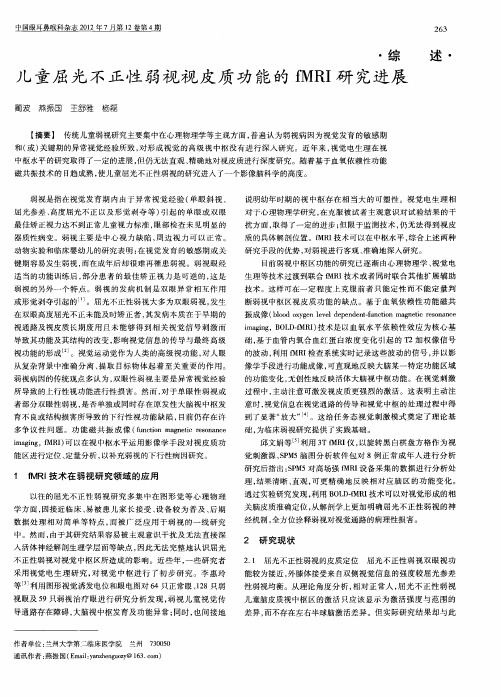
生理等技术过渡到联合 f I MR 技术或者 同时联合 其他扩展辅 助
技 术 。这 样 可 在 一 定 程 度 上 克 服 前 者 只 能 定 性 而 不 能 定 量 判
或形觉剥夺 引起 的 。屈光不正性弱视大 多为双 眼弱视 , 生 发 在双 眼高 度屈光不正未能及时矫 正者 , 其发病本 质在于早期 的
1
RI 技术 在 弱视研 究 领域 的应 用
以往 的屈光不 正性 弱视研 究多 集 中在 图形 觉 等心 理物 理
理, 结果清 晰、 直观 , 可更 精确地 反 映相对应 脑 区 的功能 变化 。
通过实验研 究发现 , 利用 B L — I O Df 技术可 以对视觉形成 的相 MR
关脑皮质准确定位 , 从解剖 学上 更加明确屈 光不正性 弱视 的神 经机制 , 全方位诠释弱视对视觉通路 的病 理性 损害。
研究手段 的优势 , 对弱视进行客观 、 准确地深入研究 。 目前弱视 中枢 区功能 的研究 已逐渐 由心理 物理学 、 视觉 电
键期容 易发生弱视 , 而在成年 后却很难 再罹患弱 视。弱视 眼经
适 当的功 能训 练后 , 分患 者的最 佳矫 正视 力是 可逆 的 , 是 部 这
弱 视 的另 外 一 个 特 点 。弱 视 的 发 病 机 制 是 双 眼 异 常 相 互 作 用
础, 为临床弱 视研 究提供了实践基础。
i g g fR ) mai , M I 可以在视 中枢水平运用 影像学 手段对 视皮质 功 n 能区进行定位 、 定量分析 , 以补充弱视 的下行性病 因研究 。
邱文娟等 利用 3 I , Tf 仪 以旋 转黑 白棋 盘方 格作为视 MR
觉刺激源 ,P 5脑 图分析 软件包对 8例 正常 成年人 进行 分 析 SM 研究后指 出:P 5对高场强 f I SM MR 设备采集 的数据进 行分析 处
儿童屈光的特点与屈光不正的处理
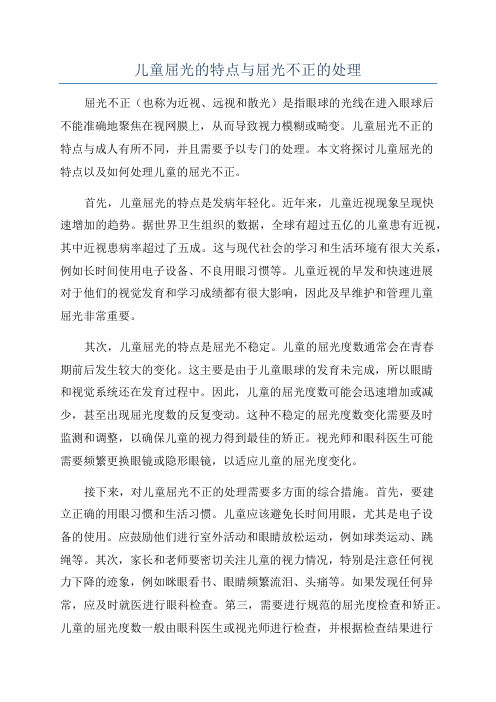
儿童屈光的特点与屈光不正的处理屈光不正(也称为近视、远视和散光)是指眼球的光线在进入眼球后不能准确地聚焦在视网膜上,从而导致视力模糊或畸变。
儿童屈光不正的特点与成人有所不同,并且需要予以专门的处理。
本文将探讨儿童屈光的特点以及如何处理儿童的屈光不正。
首先,儿童屈光的特点是发病年轻化。
近年来,儿童近视现象呈现快速增加的趋势。
据世界卫生组织的数据,全球有超过五亿的儿童患有近视,其中近视患病率超过了五成。
这与现代社会的学习和生活环境有很大关系,例如长时间使用电子设备、不良用眼习惯等。
儿童近视的早发和快速进展对于他们的视觉发育和学习成绩都有很大影响,因此及早维护和管理儿童屈光非常重要。
其次,儿童屈光的特点是屈光不稳定。
儿童的屈光度数通常会在青春期前后发生较大的变化。
这主要是由于儿童眼球的发育未完成,所以眼睛和视觉系统还在发育过程中。
因此,儿童的屈光度数可能会迅速增加或减少,甚至出现屈光度数的反复变动。
这种不稳定的屈光度数变化需要及时监测和调整,以确保儿童的视力得到最佳的矫正。
视光师和眼科医生可能需要频繁更换眼镜或隐形眼镜,以适应儿童的屈光度变化。
接下来,对儿童屈光不正的处理需要多方面的综合措施。
首先,要建立正确的用眼习惯和生活习惯。
儿童应该避免长时间用眼,尤其是电子设备的使用。
应鼓励他们进行室外活动和眼睛放松运动,例如球类运动、跳绳等。
其次,家长和老师要密切关注儿童的视力情况,特别是注意任何视力下降的迹象,例如眯眼看书、眼睛频繁流泪、头痛等。
如果发现任何异常,应及时就医进行眼科检查。
第三,需要进行规范的屈光度检查和矫正。
儿童的屈光度数一般由眼科医生或视光师进行检查,并根据检查结果进行眼镜或隐形眼镜的矫正。
在屈光变化较大的情况下,可能需要定期检查并更新眼镜配镜。
第四,儿童屈光不正管理还包括视觉训练和眼保健操。
视觉训练可以帮助儿童提高眼球的灵活性和调节功能,从而改善屈光度数。
眼保健操可以在日常生活中进行,例如远离屏幕、多看绿色植物等。
【少年儿童屈光不正1000眼验光结果分析】 屈光不正的矫正方法
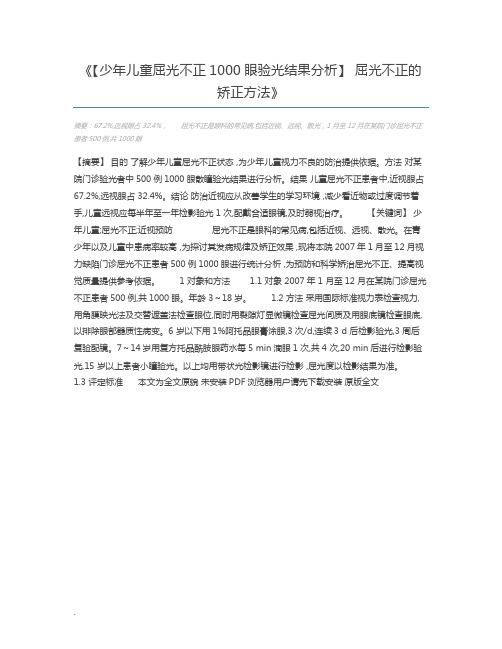
《【少年儿童屈光不正1000眼验光结果分析】屈光不正的矫正方法》摘要:67.2%,远视眼占 32.4%,屈光不正是眼科的常见病,包括近视、远视、散光,1 月至12 月在某院门诊屈光不正患者500例,共1000眼【摘要】目的了解少年儿童屈光不正状态 ,为少年儿童视力不良的防治提供依据。
方法对某院门诊验光者中500例1000 眼散瞳验光结果进行分析。
结果儿童屈光不正患者中,近视眼占67.2%,远视眼占 32.4%。
结论防治近视应从改善学生的学习环境 ,减少看近物或过度调节着手,儿童远视应每半年至一年检影验光1 次,配戴合适眼镜,及时弱视治疗。
【关键词】少年儿童;屈光不正;近视预防屈光不正是眼科的常见病,包括近视、远视、散光。
在青少年以及儿童中患病率较高 ,为探讨其发病规律及矫正效果 ,现将本院2007年1月至12月视力缺陷门诊屈光不正患者500例1000眼进行统计分析 ,为预防和科学矫治屈光不正、提高视觉质量提供参考依据。
1 对象和方法 1.1 对象 2007年 1 月至12 月在某院门诊屈光不正患者500例,共1000眼。
年龄 3~18岁。
1.2 方法采用国际标准视力表检查视力,用角膜映光法及交替遮盖法检查眼位,同时用裂隙灯显微镜检查屈光间质及用眼底镜检查眼底,以排除眼部器质性病变。
6 岁以下用1%阿托品眼膏涂眼,3次/d,连续3 d 后检影验光,3 周后复验配镜。
7~14岁用复方托品酰胺眼药水每5 min滴眼1 次,共4 次,20 min后进行检影验光,15 岁以上患者小瞳验光。
以上均用带状光检影镜进行检影 ,屈光度以检影结果为准。
1.3 评定标准本文为全文原貌未安装PDF浏览器用户请先下载安装原版全文.。
4~12岁屈光不正儿童的屈光状态及相关因素分析

4~12岁屈光不正儿童的屈光状态及相关因素分析徐翀;方慧苹;王冲;刘序华;何利标【期刊名称】《黑龙江医学》【年(卷),期】2015(000)003【摘要】ObjectiveToinvestigatetherelationshipbetweenchildrenametropiaanddevel opmentofeye.Methods 1200eyesof600 children at 4~12 years old were randomly selected, ocular growth parameters and the habits of using eyes were compared among 175 cases (313 eyes) of ametropia children and 313 control eyes.The relationship between ametropia and ocular growth and development was ana-lyzed.Results In the younger ametropia (4~6 years old) group, there was little correlation between uncorrected visualacuity( UCVA) and eye axis lenth(AL), age(Y), height(H) and weight(W) (P>0.05).In older children emmetropia group, UCVA had positive relat-ed with AL, Y, H and W ( P <0.01 ); In ametropia group, UCVA were negatively correlated with AL, Y, H and W ( P <0.01 ) . Equivalent spherical( SE) in two groups were negatively correlated with AL, Y, H and W ( P<0.01);To explore the effect of reading time contribute to the ametropia:there was no difference between the two groups (P>0.05);To evaluate the time using electronic products on ametropia:there was significant difference between the two groups (P<0.05).Conclusion Children with ametropia are closely related with the eye axis, age, height and weight, and also related withgenetic factors and time of using telectronic products.%目的:分析儿童屈光不正与眼球发育及生长发育的关系。
屈光不正儿童波前像差的研究的开题报告
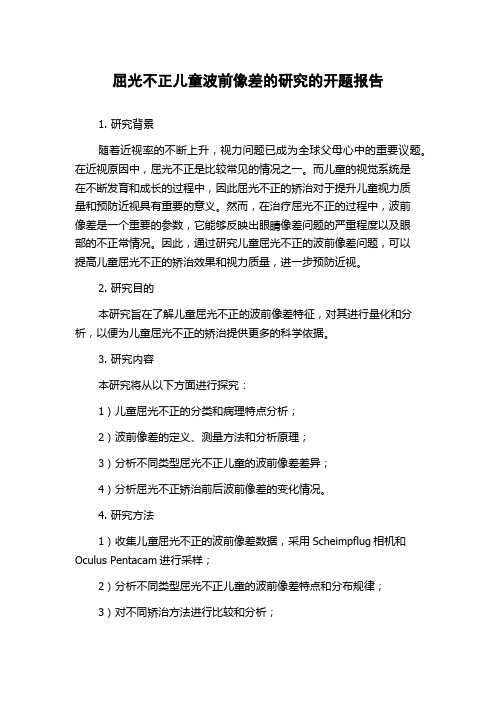
屈光不正儿童波前像差的研究的开题报告
1. 研究背景
随着近视率的不断上升,视力问题已成为全球父母心中的重要议题。
在近视原因中,屈光不正是比较常见的情况之一。
而儿童的视觉系统是
在不断发育和成长的过程中,因此屈光不正的矫治对于提升儿童视力质
量和预防近视具有重要的意义。
然而,在治疗屈光不正的过程中,波前
像差是一个重要的参数,它能够反映出眼睛像差问题的严重程度以及眼
部的不正常情况。
因此,通过研究儿童屈光不正的波前像差问题,可以
提高儿童屈光不正的矫治效果和视力质量,进一步预防近视。
2. 研究目的
本研究旨在了解儿童屈光不正的波前像差特征,对其进行量化和分析,以便为儿童屈光不正的矫治提供更多的科学依据。
3. 研究内容
本研究将从以下方面进行探究:
1)儿童屈光不正的分类和病理特点分析;
2)波前像差的定义、测量方法和分析原理;
3)分析不同类型屈光不正儿童的波前像差差异;
4)分析屈光不正矫治前后波前像差的变化情况。
4. 研究方法
1)收集儿童屈光不正的波前像差数据,采用Scheimpflug相机和Oculus Pentacam进行采样;
2)分析不同类型屈光不正儿童的波前像差特点和分布规律;
3)对不同矫治方法进行比较和分析;
4)编写相应的计算机程序,完成图像识别、数据处理和分析。
5. 研究预期成果
通过本研究的实施,我们将对儿童屈光不正的波前像差进行深入的了解和探究,能够更准确地估计眼部的异常情况,为矫治屈光不正提供更多的科学依据,同时提高儿童视力质量,进一步预防近视的发生和加重。
儿童屈光的特点与屈光不正的处理
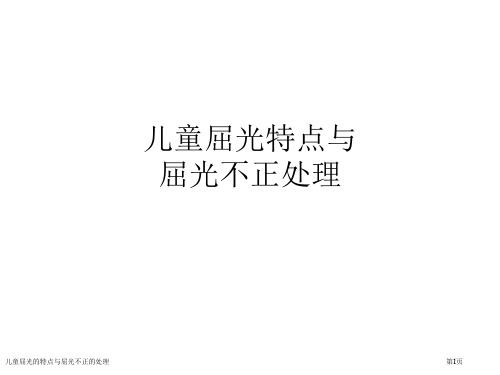
– 舒适度很好
抛弃型和高透 氧镜片是发展
方向
儿童屈光的特点与屈光不正的处理
第33页
角膜接触镜
• RGP(硬性透气性角膜接触 镜)
– 视觉质量好,可矫正不规则散 光,透氧性高,并发症少,寿命 长
– 舒适度:早期有异物感,适应较 长
– 在一定程度上阻止近视发展 (美国3年临床研究表明, RGP与软镜相比对近视进展 控制差异是0.63D,(-1.56/2.19D)
儿童屈光的特点与屈光不正的处理
第2页
眼球发育概况
– 快速发育期
• 出生3岁;眼轴16.5mm22.5mm – 慢性发育期
• 3岁18岁;眼轴22.5mm23.5mm
近视
正视
儿童屈光的特点与屈光不正的处理
远远视视
第3页
屈光要素发育特点
• 眼轴长度:从出生时16mm到发育成熟8岁,眼球 前后轴约增加6~8mm
儿童屈光特点与 屈光不正处理
儿童屈光的特点与屈光不正的处理
第1页
儿童屈光在小儿眼科中主要性
• 儿童处于生长发育阶段,视觉系统解剖、 生理、病理改变规律与成人有所不一样
• 视觉发育敏感期,屈光不正可影响视力、 眼位、双眼单视功效发育,与小儿斜视弱 视关系亲密
• 小儿屈光问题早期正确诊疗和处理非常主 要
减 • 外斜视患儿,在保障良好视力前提下欠矫
儿童屈光的特点与屈光不正的处理
第12页
远视矫正方式
• 光学镜片
– 凸透镜 – 帽子镜:高度远视
• 压贴膜:+12.00~+16.00D
– 无晶体眼
• 角膜接触镜
– RGP:婴幼儿无晶体眼
屈光不正之球面检查法
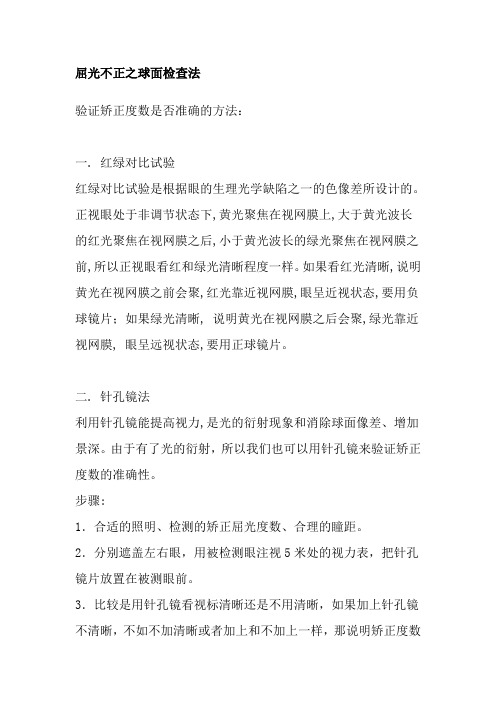
屈光不正之球面检查法验证矫正度数是否准确的方法:一. 红绿对比试验红绿对比试验是根据眼的生理光学缺陷之一的色像差所设计的。
正视眼处于非调节状态下,黄光聚焦在视网膜上,大于黄光波长的红光聚焦在视网膜之后,小于黄光波长的绿光聚焦在视网膜之前,所以正视眼看红和绿光清晰程度一样。
如果看红光清晰,说明黄光在视网膜之前会聚,红光靠近视网膜,眼呈近视状态,要用负球镜片;如果绿光清晰, 说明黄光在视网膜之后会聚,绿光靠近视网膜, 眼呈远视状态,要用正球镜片。
二. 针孔镜法利用针孔镜能提高视力,是光的衍射现象和消除球面像差、增加景深。
由于有了光的衍射,所以我们也可以用针孔镜来验证矫正度数的准确性。
步骤:1.合适的照明、检测的矫正屈光度数、合理的瞳距。
2.分别遮盖左右眼,用被检测眼注视5米处的视力表,把针孔镜片放置在被测眼前。
3.比较是用针孔镜看视标清晰还是不用清晰,如果加上针孔镜不清晰,不如不加清晰或者加上和不加上一样,那说明矫正度数是准确的。
4.如果加上针孔镜清楚,则说明矫正度数不准确。
则需要从新检查球镜、柱镜和轴位。
直到加针孔镜不如不加清晰或同样清晰。
三. 远交叉格子试验将±0.50DC的交叉柱镜放置在眼前,使负轴在90度,正轴在180度,使眼形成人为散光。
遮盖一眼,观察5米处的交叉格子视标。
这时垂直的焦线在视网膜之前,水平的焦线在视网膜之后,清晰程度相同。
如果矫正度数准确,看垂直和水平的焦线清晰程度相同。
反之,则不相同。
步骤:1.合适的照明、检测的矫正屈光度数、合理的瞳距。
2.分别遮盖左右眼,用被检测眼注视5米处的交叉格子视标, 将±0.50DC的交叉柱镜放置在眼前,使负轴在90度,正轴在180度。
3.比较交叉格子垂线和水平线清晰程度如何,若清晰程度相同,则矫正度数正确。
4.若垂直清晰,水平模糊,说明后焦线接近视网膜呈近视状态,要增加负球镜或减少正球镜。
反之,说明前焦线接近视网膜,呈远视状态,需增加正球镜或减少负球镜。
小儿屈光不正性弱视的疗效观察

小儿屈光不正性弱视的疗效观察谢姝,王朝阳(沈阳爱尔眼视光医院视光中心,辽宁沈阳110003)摘要:目的探讨小儿屈光不正性弱视的疗效,以帮助患儿在最佳时机完成治疗,保障生活质量。
方法选取本院2017年10月至2019年10月收治的186例小儿屈光不正性弱视患儿作为研究对象,根据小儿屈光不正性弱视患儿的情况分为远视性弱视组(n=93)、近视性弱视组(n= 55)和散光性弱视组(n=38);根据弱视程度分为轻度组(123只眼)、中度组(135只眼)以及重度组(14只眼);根据年龄分为3~6岁组(n=21)、7~10岁组(n=112)和11~13岁组(n=53)。
采取涂抹药物、配戴合适眼镜、遮盖健眼或交替遮盖、精细目力作业训练及弱视治疗仪等进行治疗,比较3组患儿弱视矫正情况。
结果治疗后,远视性弱视组患儿基本治愈率最高,其次为近视性弱视组,散光性弱视组基本治愈率最低;患儿弱视程度越轻,基本治愈率越高;患儿年龄越小基本治愈率越高。
结论小儿屈光不正性弱视的治疗效果与屈光状态、弱视程度、年龄密切相关。
关键词:小儿;屈光不正性弱视;疗效观察随着我国的科学技术的快速发展,我国医疗水平也得到显著提高,但我国青少年视力下降的发生率也呈现逐年上升的趋势。
弱视是在视觉发育期内因各种原因引起的单眼或双眼最佳矫正视力下降,而眼部检查无器质性病变,是一种可预防和治疗的视力缺陷疾病,患病率高达2%~4%。
若未在最佳的时机进行治疗,会直接影响青少年的正常发育,甚至导致患儿终生的视力较差。
弱视治疗的关键是在早期进行诊断,并且接受治疗。
基于此,本研究探讨小儿屈光不正性弱视的疗效,并分析小儿屈光不正性弱视患儿的相关影响因素,现报道如下。
1资料与方法1.1临床资料选取本院2017年10月至2019年10月收治的186例小儿屈光不正性弱视患儿作为研究对象,其中男124例,女62例;年龄3~14岁,平均年龄(6.5±0.64)。
根据小儿屈光不正性弱视患儿的情况分为远视性弱视组(n=93)、近视性弱视组(n=55)和散光性弱视组(n=38);根据弱视程度分为轻度组(123只眼)、中度组(135只眼)以及重度组(14只眼);根据年龄分为3~6岁组(n=21)、7~10岁组(n=112)和11~13岁组(n=53)。
屈光不正儿童的视知觉功能评估
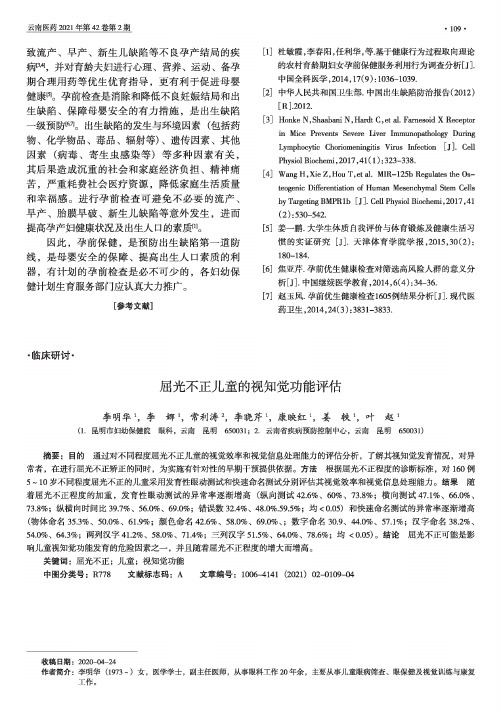
致流产、早产、新生儿缺陷等不良孕产结局的疾病刑,并对育龄夫妇进行心理、营养、运动、备孕期合理用药等优生优育指导,更有利于促进母婴健康%孕前检查是消除和降低不良妊娠结局和出生缺陷、保障母婴安全的有力措施,是出生缺陷一级预防网。
出生缺陷的发生与环境因素(包括药物、化学物品、毒品、辐射等)、遗传因素、其他因素(病毒、寄生虫感染等)等多种因素有关,其后果造成沉重的社会和家庭经济负担、精神痛苦,严重耗费社会医疗资源,降低家庭生活质量和幸福感。
进行孕前检査可避免不必要的流产、早产、胎膜早破、新生儿缺陷等意外发生,进而提高孕产妇健康状况及出生人口的素质叭因此,孕前保健,是预防出生缺陷第一道防线,是母婴安全的保障、提高出生人口素质的利器,有计划的孕前检查是必不可少的,各妇幼保健计划生育服务部门应认真大力推广。
[参考文献][1]杜敏霞,李春阳,任利华,等.基于健康行为过程取向理论的农村育龄期妇女孕前保健服务利用行为调查分析⑴.中国全科医学,2014,17(9):1036-1039.⑵中华人民共和国卫生部.中国出生缺陷防治报告(2012)[R1.2012.[3]Honke N,Shaabani N,Hardt C,et al.Famesoid X Receptorin Mice Prevents Severe Liver Immunopathology During Lymphocytic Choriomeningitis Virus Infection[j].Cell Physiol Biochemi,2017,41(1):323-338.[4] Wang H,Xie Z,Hou T,et al.MIR-125b Regulates the Os-teogenic Differentiation of Human Mesenchymal Stem Cells by Targeting BMPRlb[J]*Cell Physiol Biochemi,2017,41(2):530-542.[5]姜一鹏.大学生体质自我评价与体育锻炼及健康生活习惯的实证研究[J].天津体育学院学报,2015,30(2):180-184.[6]焦亚芹.孕前优生健康检查对筛选高风险人群的意义分析[J].中国继续医学教育,2014,6(4):34-36.[7]赵玉凤孕前优生健康检查1605例结果分析[J].现代医药卫生,2014,24(3):3831-3833.•临床研讨•屈光不正儿童的视知觉功能评估李明华1,李娜1,常利涛彳,李晓芹1,康映红1,姜轶[,叶赵1(1.昆明市妇幼保健院眼科,云南昆明650031; 2.云南省疾病预防控制中心,云南昆明650031)摘要:目的通过对不同程度屈光不正儿童的视觉效率和视觉信息处理能力的评估分析,了解其视知觉发育情况,对异常者,在进行屈光不正矫正的同时,为实施有针对性的早期干预提供依据。
- 1、下载文档前请自行甄别文档内容的完整性,平台不提供额外的编辑、内容补充、找答案等附加服务。
- 2、"仅部分预览"的文档,不可在线预览部分如存在完整性等问题,可反馈申请退款(可完整预览的文档不适用该条件!)。
- 3、如文档侵犯您的权益,请联系客服反馈,我们会尽快为您处理(人工客服工作时间:9:00-18:30)。
Hans Journal of Ophthalmology 眼科学, 2017, 6(2), 67-73Published Online June 2017 in Hans. /journal/hjo https:///10.12677/hjo.2017.62012文章引用: 孙建初, 姚婷婷. 儿童屈光不正光学生物测量的探讨[J]. 眼科学, 2017, 6(2): 67-73.A Discussion about Children with Refractive Errors of Optical Biological MeasureJiancun Sun, Tingting YaoWuxi Xinshijie Eye Hospital, Wuxi JiangsuReceived: May 22nd , 2017; accepted: Jun. 25th , 2017; published: Jun. 28th, 2017AbstractObjective: To study the relationship between the children’s eye axis, corneal curvature and refrac-tive errors. Methods: By using mydriatic retinoscopy and intraocular len-master, we have a total of 44 cases with 88 eyes of refractive errors degree, eye axis, corneal curvature, anterior chamber depth and other parameters. According to the refractive errors degree, it can be divided into hyperopia group, emmetropia group, and the myopia group, and then we used statistical methods to compare the relationship between the refractive errors and refraction parameters. Results: the eye axis: Hyperopia group was 21.58 ± 0.90 mm; emmetropia group was 23.33 ± 0.88 mm; myopia group was 24.62 ± 1.30 mm (P < 0.05). Corneal curvature radius: Hyperopia group was 7.90 ± 0.33; emmetropia group was 7.77 ± 0.29; myopia group was 7.75 ± 0.38 (P > 0.05). AL/CR: Hyperopia group was 2.74 ± 0.13 mm; the result is less than 3 (P < 0.05); Emmetropia group was 3.00 ± 0.03; the result equals to 3; Myopia group was 3.18 ± 0.12; the result is more than 3. At the same time, we also found that using AL/CR to assess the sensitivity of refractive errors and specificity degree was better. Youden index is 0.68; it prompts the titer of diagnosis was better. Conclusion: Through the detection of AL/CR (≤3 or >3), we can well predict the development trend of refractive errors, and provide prospective for myopia prevention and early intervention of guidance.KeywordsRefractive Errors, Eye Axis, Corneal Curvature Radius儿童屈光不正光学生物测量的探讨孙建初,姚婷婷无锡新视界眼科医院,江苏 无锡收稿日期:2017年5月22日;录用日期:2017年6月25日;发布日期:2017年6月28日孙建初,姚婷婷摘要目的:研究探讨儿童眼轴、角膜曲率与屈光不正的关系。
方法:通过在睫状肌麻痹状态下检影验光及光学生物测量仪—IOL Master获得44例88眼的屈光不正度数、眼轴、角膜曲率、前房深度等参数。
按屈光不正度数分为远视组、正视组、近视组,应用统计学方法比较屈光不正与各屈光参数之间的关系。
结果:受试者眼轴:远视组为21.58 ± 0.90 mm,正视组为23.33 ± 0.88 mm,近视组为24.62 ± 1.30 mm (P <0.05)。
角膜曲率半径:远视组为7.90 ± 0.33,正视组为7.77 ± 0.29,近视组为7.75 ± 0.38 (P > 0.05)。
轴率比值:远视眼组为2.74 ± 0.13 mm,其结果小于3;正视眼组为3.00 ± 0.03 mm,其结果约等于3;近视眼组为3.18 ± 0.12 mm,其结果大于3(P < 0.05);同时也发现用轴率比指标来评估近视、远视的灵敏度和特异度均较高,Youden指数0.68,提示诊断效价较好。
结论:检测分析轴率比值(≤3或>3)可以很好预测屈光不正的发展趋势,并为近视的早期预防和干预提供前瞻性的指导。
关键词屈光不正,眼轴,角膜曲率半径Copyright © 2017 by authors and Hans Publishers Inc.This work is licensed under the Creative Commons Attribution International License (CC BY)./licenses/by/4.0/1. 引言学龄前儿童正处在视觉发育可塑性的关键期,随着年龄的增长屈光状态从生理性远视逐渐向正视甚至近视方向发展,其眼部屈光结构如眼轴、角膜屈光力、晶状体屈光力、前房深度等也随之而改变,均有碍于儿童视力和屈光发育的健康发展。
在我国以往的研究中,长期以来主要是对近视的调查大都停留在流行病学特点上,而对眼生物学参数的特点报道甚少,因此我们从各屈光参数入手,通过屈光要素的生物学测量值对屈光不正的发生原因进行研究,共收集了44例3~15岁儿童的资料,旨在研究眼轴、角膜曲率、前房深度、年龄与屈光状态之间的关系并进行分析探讨。
2. 资料和方法对象2016年10月至2017年2月来我院就诊,疑有屈光不正的儿童44例88只眼,其中男21例42只眼,女23例46只眼,年龄3~15岁。
1) 对象本研究所采用的受试者为2016年10月~2017年3月在本院就诊的儿童,年龄3~15 (平均9.04± 2.39)岁,共44例88眼,其中男21例,女23例。
所有受试者均接受裂隙灯检查、眼底检查,排除眼部器质性疾病、屈光参差、斜视者;并告知本研究目的,征得家长的同意后再行检查。
3. 测量方法1) 采用国际标准对数视力表对所有儿童均进行裸眼及验光矫正视力,受检距离5 m,照度值(160cd/m2) [1],先右眼后左眼,直至看清最小视标记录检查结果;选用日本Topcon公司生产的RM-8000电脑验光仪进行电脑验光,测量3次,取平均值。
2) 对11岁以下儿童用1%阿托品凝胶慢散扩瞳,bid × 3d;12岁以上儿童用美多丽(复方托品酰胺滴孙建初,姚婷婷眼液,Mydrin,Sentan,日本)快散扩瞳,10 min/1次× 4次,后隔20 min;均在暗室检影验光,确定屈光状态结果、眼底及注视性质、眼位及眼球运动检查,排除眼部器质性病变、既往眼部手术史者。
3) 采用德国Zeiss公司生产的光学生物测量仪—IOL-Master进行检查。
受检者下颌置于仪器的下颌托上,令其注视仪器中的视标,当仪器的探头离受检者大约5.5 cm时进行对焦,然后分别测量双眼的眼轴长度(axial length, AL)、前房深度(anterior chamber depth, ACD),均重复测量5次并取平均值;角膜曲率(corneal curvature, CC),均重复3次并取其平均曲率。
4) 本研究所有操作均由专业检查者操作完成,并严格遵守操作标准。
4. 统计学方法数据处理采用SPSS17.0统计软件,以P < 0.05为差异有统计学意义。
根据公式角膜曲率均值K = (K1 + K2)/2 [2]、角膜曲率半径(CR) = 1000(n2 − n1)/K [3] [4],计算出轴率比(AL/CR)。
AL、CR、睫状肌麻痹状态下的等效球镜(SE)等定量数据,均需提前进行正态性检测。
研究AL/CR与SE间数据的相关性采用SPEARMAN相关分析;不同条件下同组数据的差异性应用单因素方差分析法;计算轴率比诊断儿童近视的真实可靠性,根据近视的真阳性a与假阳性b,假阴性c与真阴性d,再运用公式灵敏度= a/(a + c),特异度= d/b + d,Youden指数= 灵敏度+ 特异度− 1算得。
5. 结果5.1. 一般资料受试者44例88眼,其中男21例,女23例,年龄3~15 (平均8.95 ± 2.96)岁,等效球镜(SE) −10.00~10.00 D;远视组13眼,男7眼,女6眼,平均年龄8.07±2.14岁,平均SE为+3.65 ± 2.88 D;正视组20眼,男8眼,女12眼,平均年龄8.83 ± 2.28岁,平均SE为+0.04 ± 0.31 D;近视组55眼,男27眼,女28眼,平均年龄10.58 ± 2.54岁,平均SE为−3.80 ± 1.88 D (见表5)。
